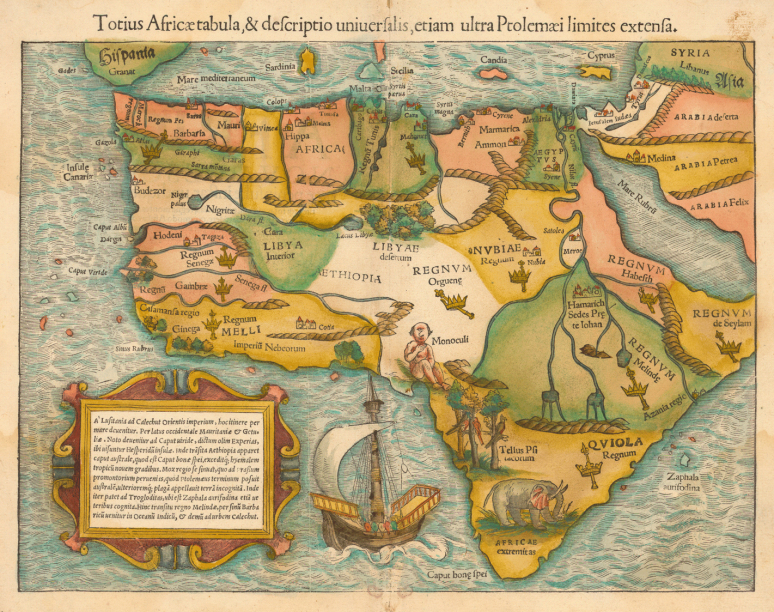This Earliest Map Of Africa Was Created In 1554 By A German Who Had Never Stepped Foot On The continent
- Home
- This Earliest Map Of Africa Was Created In 1554 By A German Who Had Never Stepped Foot On The continent

This Earliest Map Of Africa Was Created In 1554 By A German Who Had Never Stepped Foot On The continent

Our ancestors of the Pharaonic civilization spent considerable time mapping out everything about the world around them. So they must have at some point in their curiosity-driven adventures traced out the outline of their continent on a piece of parchment, or most probably on a clay tablet using a papyrus reed. The documented evidence of their cartographic genius is, however, found missing from the annals of history, or maybe buried along with a yet-to-be-discovered Pharaoh.
The ancient Egyptians carried out military expeditions, trade missions as well as seafaring adventures to discover new lands and cultures. One of such voyages was carried out in 1493 BC and the documented account concerning this sea travel is etched into the walls of the Dier-el-Baharitemple, but there are no mentions of cartographic maps employed by the ancient Egyptians in their seafaring adventures.
Herodotus (484-425BC), the Greek adventurer and historian documented an account of Pharaoh Necho’s travel around the continent during the 6th century BC. Pharaoh Necho II (596 – 594 BC) and his expedition sailed down the Red Sea from the ancient Egyptian Kingdom, succeeding in circumnavigating the entire continent of Africa upon their return to the city of Alexandria. Once again, tangible evidence surrounding the use of a map of Afrika on their sea voyage is absent.
Modern-day makers of maps (cartographers) and travelling scholars who study politically divided land masses (geographers) have submitted that; the African continent covers a respectable 11,724,000 square miles of land mass. From her northernmost point (Ras Ben Sakka, Tunisia) to her southernmost point (Cape Agulhas) in South Africa, the continent of Africa measures 5000 miles. And from her westernmost point (Cape Verde) to her easternmost point (Ras Hafun, Somalia) she measures 4,600 miles.
Africa covers 6% of Earth’s estimated total surface area and 20.4% of Earth’s land mass. It is also noteworthy to mention that Africa is the only continent that shares considerably in the space provided for by both the northern and southern hemispheres of the Earth. Geographical knowledge avails that the African continent is near-equally divided by the imaginary line named ‘Equator’, passing through her supposed centre and mother Africa is home to the human race; a scientific and historical truth made evident by the discovery of the remains of our earliest human ancestors in Olduvai Gorge, East Africa by the Leakeys.
The information above is one that has been made available by virtue of investigations carried out by their respective experts given the past century. But since our Pharaonic ancestors left no known physical documentation of Africa’s continental outline, we are moved by our own curiosity to investigate into what the African continent looked like before now. Our inquiry into this matter can only take us as far back as 1554 when the scholar; Sebastian Munster put together the first known map of Africa.
Sebastian Munster was a German mathematician, geographer and a professor of Hebrew at Heidelberg and subsequently, Basel. His 1554 map-work of Africa is a rather interesting one considering the fact that he had not stepped foot on the continent of Africa himself at the time he created the map. His map of Africa which is considered; the earliest known map reveals a continent with a relatively bigger land mass as compared to subsequent maps of the African continent in the ensuing years per visual comparison.
The graphical illustration of the map consists of; colour patches representative of kingdoms most probably, crowns with staves in the hollow of their interior, river courses, birds, a Cyclops and an elephant stationed at the southernmost part of the map all surrounded by water. The land area occupied by the Sahara Desert on present-day maps of Africa was per Sebastian’s 1554 map, a dense forest.

Image source: worldhistoryarchive.wordpress.com
Questions have been raised concerning the ‘mythical’ Cyclops comfortably seated on an area of the map presently occupied by some portions of the independent African nations of Nigeria and Cameroon with the label; ‘Monoculi’ inscribed beside it. Some claim the Cyclops represents a tribe of one-eyed people that inhabited the part of the map where it is seated. Or could it be an extraneous feature inserted to make up for the lack of detail given the fact that the maker of the map had himself prior to making it not experienced the African continent in person?
Sebastian Munster created the map of Africa from a collection of accounts and piecemeal maps accessed from travelling scholars and colleague ‘geographers’ of his time, culminating in the making of the first woodcut production of the Afrikan continent on European soil. This accounts for why important details such as the estimated land mass size and the Island of Madagascar are missing given the map in question.
Sebastian Munster’s 1554 map of Africa aroused intense curiosity about the continent of Afrika, it inspired the art of cartography all over Europe and led to subsequent African map productions of more refined features and detailed orientation.
Source: Face2face Africa
Classic Ghana
Classic Ghana brings you into a fun world of arts, entertainment, fashion, beauty, photography, culture and all things in between. Let’s explore these together!


